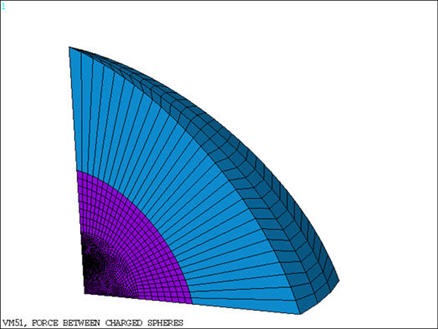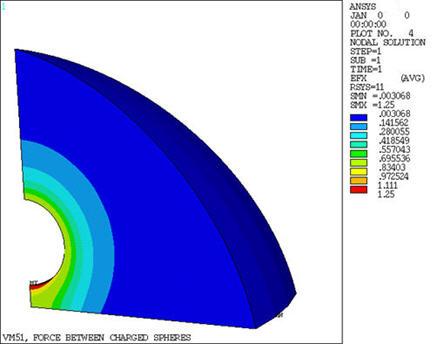VM51
VM51
Electrostatic Forces Between Charged Spheres
Overview
| Reference: | Any General Physics Textbook |
| Analysis Type(s): | Electrostatic Analysis (ANTYPE = 0) |
| Element Type(s): | |
| Input Listing: |
VM51 requires a supplemental .cdb input file which is too long to include full input listings. This file must be downloaded and placed in your working directory for the test case to run properly. Additionally, the geometry and mesh should be regenerated. Download link: MAPDL Test Case Files for 2024 R2 vm51_case1.cdb vm51_case2.cdb |
Test Case
Two spheres with radii = 1 m, separated by a distance of 3 m, are subjected to a surface charge. Find the resultant electrostatic force between the spheres.
| Material Properties | Geometric Properties | Loading | ||||||
|---|---|---|---|---|---|---|---|---|
|
|
|
Analysis Assumptions and Modeling Notes
The finite element mesh and the infinite element mesh are generated from the solid model. A planar section of the model is meshed with PLANE121 elements and rotated through 30 degrees. The 2D mesh creates a 3D mesh of SOLID122 elements. SHELL281 elements are generated over the outer surface of the 3D mesh and extruded in the radial direction to complete the finite element domain. The process is repeated to extrude the INFIN111 mesh in the radial direction.
It can be assumed that a symmetry plane exists at Y = 0, at which a zero voltage constraint is imposed. Infinite flags are set for the outer surface of the INFIN111 elements.
The same problem is then solved using SOLID123 elements
The theoretical solution is:
where ε = 8.854E-12, q1 = q2 = 4* π* ε. This charge corresponds to a surface force of ε on the sphere.
surface charge = q/area = (4* π* ε )/4* π*(r1**2) = ε






